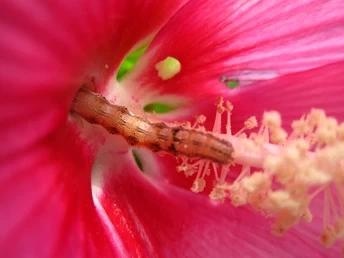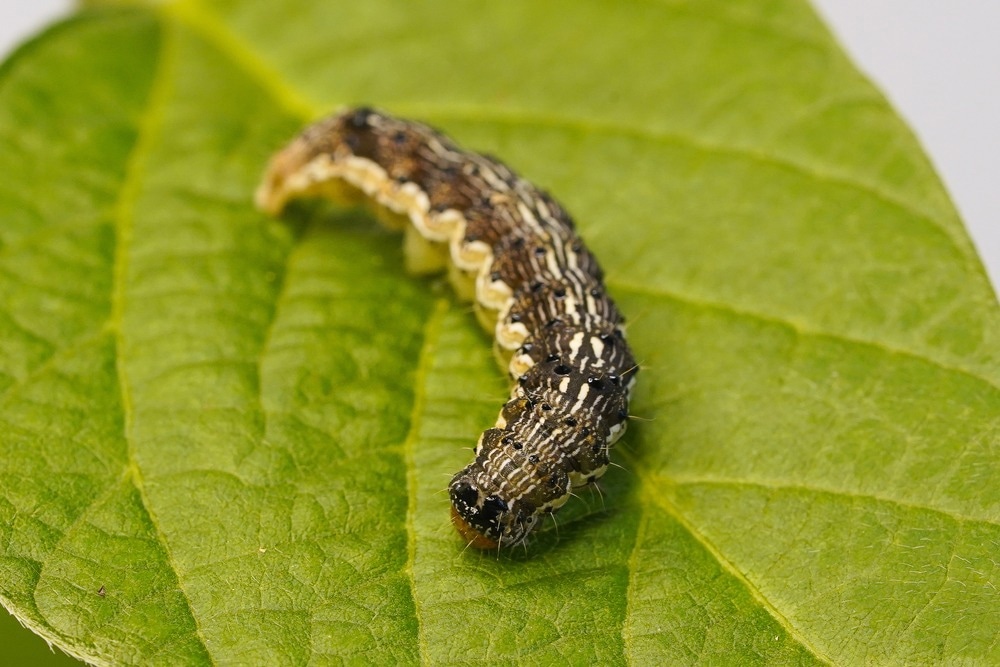Reviewed by Danielle Ellis, B.Sc.Nov 8 2023
New research reveals that the cotton bollworm (Helicoverpa armigera) employs distinct sugar-sensing mechanisms in its larval and adult stages to fulfill its dietary preferences.
 Image showing a cotton bollworm (Helicoverpa armigera) larvae feeding on the fruit of Alcea rosea, the common hollyhock. Image credit: Chen-Zhu Wang (CC BY 4.0).
Image showing a cotton bollworm (Helicoverpa armigera) larvae feeding on the fruit of Alcea rosea, the common hollyhock. Image credit: Chen-Zhu Wang (CC BY 4.0).
In a recent publication featured as a Reviewed Preprint in eLife, the study has been lauded as significant by the editorial team. It presents compelling evidence that distinct gustatory receptors governing sugar detection underlie the shift in dietary preferences between larval and adult cotton bollworms.
These findings, when coupled with further investigations, could propose a novel approach to pest control aimed at enhancing global crop yields. The cotton bollworm, a notorious pest with a worldwide presence, is responsible for an annual economic loss of approximately USD$3 billion.

Image Credit: Maurien trabbold/Shutterstock.com
During its juvenile, larval phase, the cotton bollworm primarily consumes leaves, flower buds, and plant fruits with relatively low sugar content. In contrast, as an adult, it predominantly feeds on the sugar-rich nectar of plants.
Previous studies have already revealed the existence of external gustatory sensory neurons (GSNs) in the cotton bollworm, specialized nerve cells responsible for detecting and transmitting taste signals to the brain, which are sensitive to sucrose and fructose.
In larvae, these GSNs are situated in specialized structures around their mouth, while in adults, they are located in their antennae, the tarsi (the segments of the leg furthest from the body), and a specialized feeding structure called the proboscis, which functions similarly to the human tongue.
The larval and adult diets of the cotton bollworm vary dramatically in their variety and concentration of sugars. Sucrose is the major sugar found in plant tissues, whereas nectar mainly contains sucrose, fructose and glucose. We aimed to characterize the molecular basis for the change in diet seen between the cotton bollworm’s two life phases.”
Shuai-Shuai Zhang, Study Lead Author and PhD Student, State Key Laboratory of Integrated Management of Pest Insects and Rodents, Institute of Zoology, Chinese Academy of Sciences
Zhang and their research team initiated their investigation by comparing the electro-physiological and behavioral reactions of cotton bollworm larvae and adults to seven plant-derived sugars, which included sucrose, fructose, and glucose.
Their findings confirmed the presence of sugar-detecting gustatory sensory neurons (GSNs) in both larvae and adults, but these neurons exhibited significant discrepancies in their response profiles, intensity, and sensitivity.
Larval sugar GSNs exhibited a robust response to sucrose, characterized by high sensitivity, being between 100 to 1,000 times more responsive to sucrose than their adult counterparts. In contrast, adult GSNs responded to sucrose, fucose, and fructose with lower intensity and sensitivity.
This heightened sensitivity in larvae is likely an adaptation to help them locate sucrose in the relatively sugar-scarce plant tissues.
Subsequently, the research team conducted an analysis of the expression and functionality of nine candidate sugar gustatory receptor (GR) genes in the taste organs of both larval and adult cotton bollworms, encompassing Gr4 to Gr12.
Given the known function of Gr9, the researchers evaluated the functionality of the remaining eight GRs using Xenopus oocytes, unfertilized eggs from African clawed frogs, commonly employed in scientific research due to their size and manipulability. The team introduced DNA sequences for each GR gene into individual oocytes and then assessed each oocyte's response to 11 different sugar compounds.
While most oocytes displayed no response, those expressing Gr10 and Gr6 exhibited reactivity to one or more sugars, signifying their involvement in food recognition. Gr10 was identified as being specifically attuned to sucrose, whereas Gr6 demonstrated responsiveness to sucrose, fucose, and fructose.
Finally, Zhang and their colleagues employed CRISPR/Cas9 DNA modification techniques to generate two homozygous mutants of cotton bollworms, each lacking the functional Gr6 or Gr10 gene.
The team’s objective was to detect any alterations in the electro-physiological and behavioral reactions of the mutant larvae and adults when exposed to sugars, in comparison to typical cotton bollworms.
Their investigation unveiled that Gr10 plays a pivotal role in sucrose perception by the sugar-sensing gustatory sensory neurons (GSNs) in larvae, contributing to the larvae’s preference for sucrose. Conversely, Gr6 is responsible for detecting sucrose, fucose, and fructose in the GSNs of adult cotton bollworms.
In summary, the findings indicate that larval and adult cotton bollworms rely on distinct gustatory receptor genes for the detection of sucrose in their diet. Larvae predominantly employ Gr10 to sense the limited sucrose content within plant tissues, while adults primarily use Gr6 to detect a range of sugars, including sucrose-rich nectar.
Both the authors and the editors emphasize that, to fully elucidate the mechanisms of sugar sensing and develop a novel pest control strategy, it is imperative to conduct a comprehensive examination of the functions of all the gustatory receptors (GRs) involved in sucrose perception.
We’ve reported the molecular basis of sucrose reception in the eternal taste neurons of the cotton bollworm, and discovered that different taste receptors underlie the difference in food selection between the adult and larval stages.”
Chen-Zhu Wang, Study Senior Author and Professor, State Key Laboratory of Integrated Management of Pest Insects and Rodents, Institute of Zoology, Chinese Academy of Sciences
Wang added, “GRs closely associated with Gr10 and Gr6 are also found in other moth and butterfly species. We therefore speculate that similar sugar-sensing mechanisms may also exist in these species, which is worth verifying with future research.”
Source:
Journal reference:
Zhang, S-S., et al. (2023) Sucrose taste receptors differ in larval and adult stages of a moth. eLife. doi.org/10.7554/eLife.91711.1.